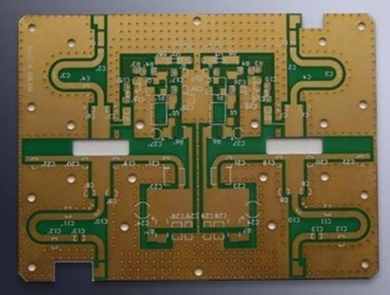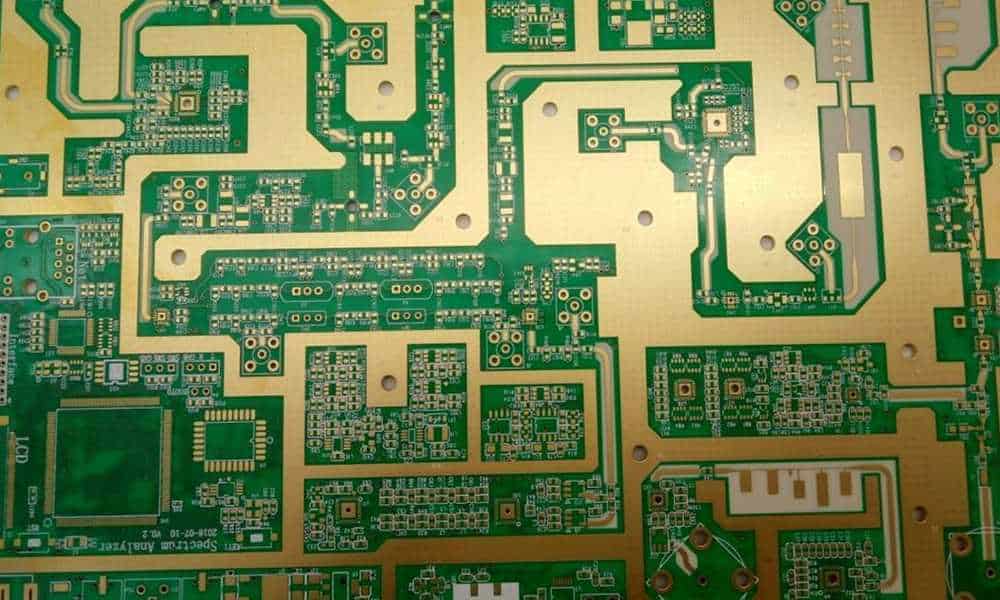Introduction
Rogers 4003C is a widely used thermoset ceramic-filled PTFE composite laminate material engineered for performance sensitive radio frequency (RF) and microwave printed circuit boards (PCBs). It offers a unique combination of electrical, mechanical and thermal properties that make it ideal for many high frequency applications.
In this article, we delve into the 4003C datasheet to understand its key material properties, dielectric constant, loss characteristics, design considerations, and typical applications.
Overview of Rogers 4003C
Rogers 4003C is a ceramic-filled PTFE composite material that offers:
- Stable dielectric constant of 3.38 over frequency
- Low loss tangent of 0.0027 at 10 GHz
- Hydrocarbon based thermoset system
- Woven glass reinforcement for dimensional stability
- Excellent thermal conductivity of 0.71 W/m/K
- UL 94V-0 flammability rating
- Lead-free compatible and RoHS compliant
- Common material thicknesses from 0.002″ to 0.062″
It is well suited for performance sensitive microwave circuits and aerospace applications requiring low loss, tight dielectric constant control, and high reliability under extreme conditions.
Key Electrical Properties

Rogers 4003C has precisely controlled electrical characteristics:
Dielectric Constant – Stable value of 3.38 (+/-0.05) over the entire frequency range of 1 GHz to 10 GHz.
Loss Tangent – Low loss of 0.0027 measured at 10 GHz, and 0.0013 at 1 MHz.
DC Breakdown – High voltage withstand of >3.0 kV allows increased board spacing.
Volume Resistivity – Uniform value of 1×10^13 ohm-cm across different 4003C laminate grades.
Arc Resistance – Excellent anti-arcing properties with typical value of 188 seconds on 0.060″ thick 4003C.
Dissipation Factor – Low value of 0.0012 at 1 MHz frequency. Enables high frequency efficiency.
These properties make 4003C highly suited for microwave and other RF applications requiring stability, low loss, and reliability under electrical stresses.
Key Mechanical Properties
Rogers 4003C features consistent mechanical properties:
Density – Uniform density of 1.8 g/cc across all standard thicknesses. Provides predictable mechanical stability.
Flexural Strength – With 106 MPa typical rating along grain/length, 4003C has high flexural rigidity for stiffness.
Compressive Modulus – Very stable modulus of 3103 MPa in all sheet directions allows modeling of deformations.
Peel Strength – Copper bond strength exceeds 9.3 N/mm for all standard copper weights.
Coefficient of Thermal Expansion (CTE) – Has an X-Y CTE of 17.5 ppm/°C and Z CTE of 32.5 ppm/°C through the laminate thickness.
The well-balanced mechanical properties of 4003C ensure excellent dimensional and structural stability during PCB fabrication and reliability in end use conditions.
Key Thermal Properties
Rogers 4003C offers very consistent thermal characteristics:
Thermal Conductivity – Has an in-plane value of 0.71 W/m/K for efficient in-plane heat spreading.
Specific Heat – Uniform specific heat of 1.045 J/g/°C.
Maximum Operating Temperature – Can reliably operate continuously at 130°C with intermittent excursions to 150°C.
Decomposition Temperature – Decomposes rapidly above 327°C.
Coefficient of Thermal Expansion (CTE) – X-Y CTE of 17 ppm/°C and Z CTE of 32.5 ppm/°C.
The thermal conductivity ensures effective heat dissipation in high power PCBs while the moderate CTE provides design flexibility.
Design Considerations for 4003C Material
Some key design considerations when working with Rogers 4003C PCB material include:
Dielectric Constant Control – The stable dielectric constant of 3.38 +/- 0.05 allows precision impedance control of traces and transmission lines.
Loss Tangent – The low loss enables high frequency efficiency in microwave circuits with minimal signal degradation.
Voids in Bonding – Use high filler content prepregs and proper lamination pressure to prevent gap formation.
Drilling – Carbide drills with >140 degree points are recommended for clean hole walls. Single-pass drilling is preferred.
Hole Wall Preparation – Desmear hole walls thoroughly to enable uniform copper plating adhesion.
Etching – Avoid over-etching which can lower dielectric thickness and impact impedances.
Signal Routing – Keep high frequency traces short. Route noise-sensitive signals internally.
Plane Separation – Use minimum two plane thicknesses dielectric to prevent arcing or breakdown between power and ground planes.
Lamination – Use low flow prepregs with 300-350°F cure temperature range. Allow a bake-out stage before temperature ramp.
Lead-free Soldering – Allowable for lead-free profiles with peak temperature up to 260°C for up to 60 seconds.
Typical Applications of Rogers 4003C

Some common applications leveraging the electrical and mechanical benefits of Rogers 4003C laminates include:
Microwave & Telecom – Oscillators, couplers, mixers, filters, antennas, point-to-point links, radar and satellite systems.
Wireless Infrastructure – Base station power amplifiers and transceivers.
Avionics – Aerospace and defense communications, instrumentation and navigation systems.
Test & Measurement – Equipment for 5G, WiFi, automotive radar, networking and aerospace/defense.
High Speed Digital – Ultra low-loss material keeps signals clean at multi-GHz frequencies in high speed data and computing systems.
Rogers 4003C Material Summary
In summary, Rogers 4003C woven glass reinforced PTFE composite offers:
- Extremely low loss tangent of 0.0027 at 10 GHz.
- Stable dielectric constant of 3.38 from 1-10 GHz.
- Tight thickness and property consistency across all sheets.
- High reliability and performance stability from -55 to +150°C.
- Lead-free compatibility and RoHS compliance.
- UL 94V-0 flammability rating.
These properties make Rogers 4003C a premier material for engineered RF/microwave PCB applications where electrical performance and quality are vital.
Conclusion
Rogers 4003C material provides a precise dielectric constant of 3.38 and low loss tangent combined with robust mechanical properties and consistency. This makes it ideal for usage in a wide range of microwave and other radio frequency PCB applications where electrical stability, low signal loss and reliability under extremes are paramount. When designed properly, Rogers 4003C delivers outstanding performance that suits the needs of leading-edge RF and microwave systems.
Frequently Asked Questions
Q1. Can Rogers 4003C be used for multilayer boards?
Yes, Rogers 4003C material can be incorporated in RF/microwave multilayer boards to provide stable dielectric properties throughout the stackup.
Q2. What are the common available thicknesses of 4003C?
4003C is typically available in thicknesses from 0.002″ (0.05mm) to 0.062″ (1.575mm) in various standard size sheets. Custom thicknesses are possible too.
Q3. Does 4003C require special hole preparation before plating?
Yes, desmear processing using permanganate or plasma is recommended after drilling 4003C material to properly etch the hole walls and enable copper plating adhesion.
Q4. What is the glass transition temperature of Rogers 4003C?
Rogers 4003C has a high glass transition temperature of 280°C, which provides excellent thermal performance stability suitable for lead-free assembly processes.
Q5. Can 4003C material be cryogenically frozen?
Yes, 4003C has been extensively tested down to cryogenic temperatures of -195°C and maintains stable electrical and mechanical properties.





